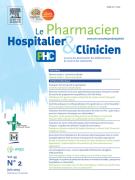Analytic method to determine the estriol concentration of a vaginal cream - 22/03/17
Résumé |
Background & objectives |
Estriol vaginal cream 0.1mg/g is a frequently requested prescription, for which there is no commercial product available in Switzerland. Thus, small-scale batches of this product are repeatedly produced in the hospital.
To produce this product at a more efficient, larger scale, we had to experiment with a method for upscaling the compounding as well as to develop an analytic method to determine the final concentration of estriol from a cream with many components. Here, we describe a fast and highly reproducible method to measure estriol concentrations by HPLC.
Methods |
Since there was no published method that described sample preparation and processing of an estriol cream, we started out with the application 124932 of Marcherey Nagel that describes the separation of various steroids by HPLC. For the challenging process to reliably extract estriol from the cream and analyze its concentration, we tested several solvents and combinations thereof.
Results |
After many trials, we found that simplest and most reliable extraction method was to dissolve 1g of cream (100μg estriol) in 50mL of methanol under hot water. While some of the cream precipitated upon cooling, 1mL of the supernatant was removed, potentially undissolved particles were removed with a hydrophilic PTFE filter, and 50μL (100ng) were injected and analyzed by UV at 205nm. Estriol was found to elute as a first peak followed by two major peaks that most likely represent parabens from the creams. Compared to a solution of micronized estriol, the recovery rate of the estriol from the cream was within 100±1% of the expected. The concentrations of the estriol samples measured from the first validation production of 12kg cream were within −1.9 and +3.6% of the expected. HPLC-method: estriol concentrations were found to decrease in a linear fashion down to 1% of the standard with a regression coefficient of R2=0.999. At a concentration of 1%, we found a signal/noise ratio of 11.07 and a relative standard deviation of 1.08. With a standard deviation of<1%, the method showed a repeatability of the system suitability test SST of ±1% and a stability of ±2% over 52hours.
Discussion & conclusions |
We developed a fast, simple and reliable method to determine the concentration of estriol from a cream with several components. Because estriol dissolves well in the methanol, the method showed a very good recovery rate of close to 100%. Since the method can detect estriol down to 1% (1ng) of the standard concentration, it can be used for cleaning validation and may serve as starting recipe for similar applications.
Le texte complet de cet article est disponible en PDF.Plan
Vol 52 - N° 1
P. e35 - mars 2017 Retour au numéroBienvenue sur EM-consulte, la référence des professionnels de santé.
L’accès au texte intégral de cet article nécessite un abonnement.
Déjà abonné à cette revue ?


